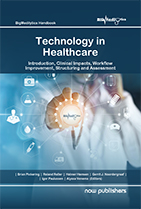Technology in Healthcare: Introduction, Clinical Impacts, Workflow Improvement, Structuring and Assessment

By Brian Pickering, University of Southampton, UK | Roland Roller, Deutsches Forschungszentrum für Künstliche Intelligenz, DFKI, Germany | Holmer Hemsen, Deutsches Forschungszentrum für Künstliche Intelligenz, DFKI, Germany | Gerrit J. Noordergraaf, Elisabeth-TweeSteden Hospital, ETZ, The Netherlands | Igor Paulussen, Elisabeth-TweeSteden Hospital & Philips Research, The Netherlands, i.paulussen@etz.nl | Alyssa Venema, Elisabeth-TweeSteden Hospital, The Netherlands
Publication Date: 08 Jul 2024
Suggested Citation: Brian Pickering, Roland Roller, Holmer Hemsen, Gerrit J. Noordergraaf, Igor Paulussen, Alyssa Venema (2024), "Technology in Healthcare: Introduction, Clinical Impacts, Workflow Improvement, Structuring and Assessment", Boston-Delft: now publishers, http://dx.doi.org/10.1561/9781638282372
Downloaded: 129843 times
Description
Healthcare systems around the world are grappling with several major challenges such as the growing prevalence of chronic diseases, rising healthcare costs, and a shortage of healthcare workers. Without action, the Organisation for Economic Co-operation and Development has estimated that the average public spending on healthcare costs will increase to 10% of GDP. The shortage of healthcare workers has been a long-standing issue in Europe, even before the COVID-19 pandemic. According to a 2018 report by the European Commission's Joint Research Centre, there was a shortage of over 1 million healthcare workers across the European Union. Such shortages have resulted in longer waiting times for patients, increased workload and stress for healthcare workers, and lower quality of care for patients. The pandemic has further underscored the importance of addressing this issue and ensuring that healthcare systems have adequate capacity to meet the needs of patients, both now and in the future.
It is clear that the healthcare sector needs to undergo radical changes to ensure that future generations have easy access to quality care that is also affordable. One way to achieve this is by leveraging the increasing use of digitization in the sector. According to a 2019 report by the European Commission, the volume of healthcare data in the EU could reach 2.8 zettabytes by 2020, with an annual growth rate of 36%. The question then is, how can we leverage the insights that lie within this vast amount of data to transform the healthcare sector and address its most pressing issues, namely cost, quality, and accessibility of care.
This book captures the learnings from the BigMedilytics project, funded by the EC from 2018 to 2021. The project aimed to transform Europe’s healthcare sector by using state-of-the-art Big Data technologies to achieve breakthrough productivity in the sector by reducing cost, improving patient outcomes, and delivering better access to healthcare facilities, covering the entire Healthcare Continuum. The project executed 12 real-life, in-hospital, big data pilots across three different themes: (i) Population health and chronic disease management, (ii) Oncology, and (iii) Industrialization of healthcare. The pilots spanned 8 European countries, the health data of 11 million patients, involved 35 consortium partners, and incorporated diverse data sets originating from the public health sector, insurance companies, IoT devices, pharmaceutical industry, and public data sets.
-
ISBN: 978-1-63828-237-2
434 pp. Open Access (.pdf) This is published under the terms of CC BY-NC
